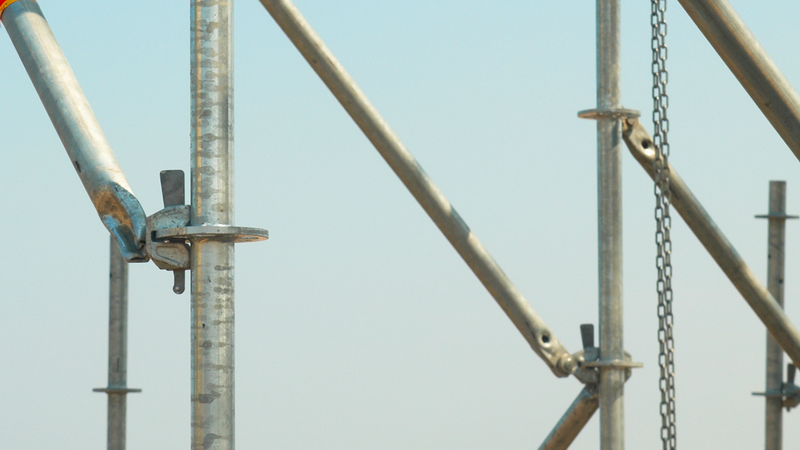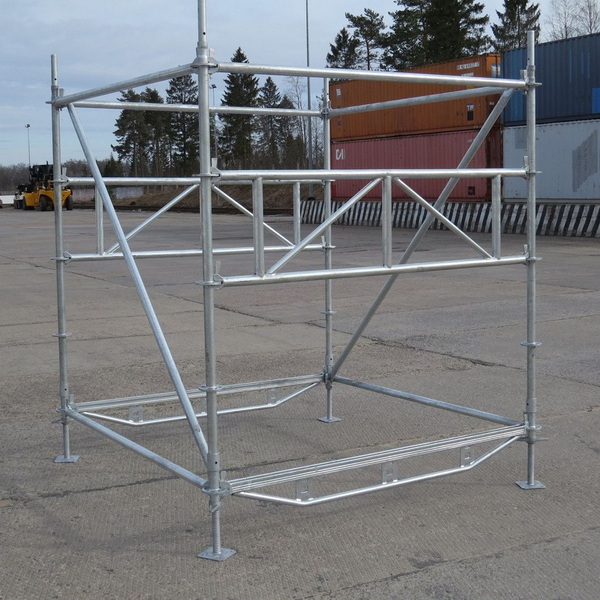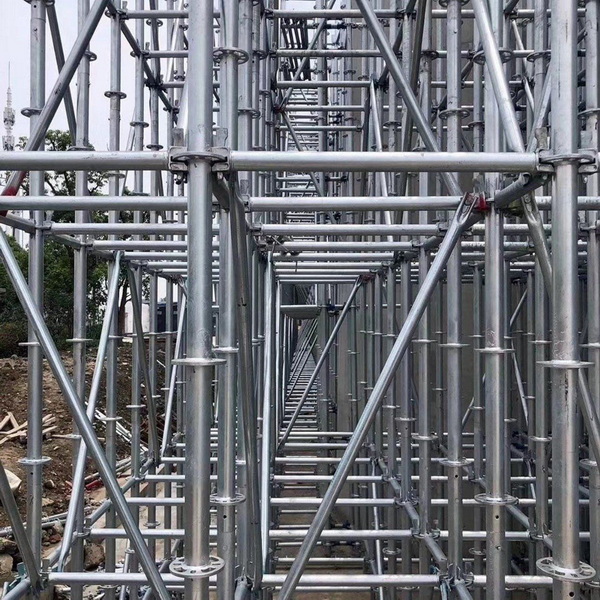Content Menu
● What is Ringlock Scaffolding?
● How Ringlock Scaffolding Enables Speed and Efficiency on Construction Sites
>> 1. Simplified and Rapid Assembly Process
>> 2. Modular Design Supports Custom and Complex Structures
>> 3. Reduced Handling of Components
● The Strength and Stability Factor Accelerating Construction
>> 1. High Load-Bearing Capacity for Heavy-Duty Tasks
>> 2. Stability in Harsh Conditions
>> 3. Enhanced Joint Integrity and Durability
● Labor and Cost Efficiency Contributing to Faster Schedules
>> 1. Reduced Labor Requirements and Skill Barriers
>> 2. Less Equipment and Transport Complexity
>> 3. Fewer Parts, Less Complexity
● Real-World Examples: Industry Applications That Leverage Ringlock for Speed
>> Industrial Maintenance and Refurbishment
>> Commercial Construction
>> Infrastructure Projects
>> Events and Temporary Structures
● Safety and Compliance: Supporting Fast Construction Without Compromising Standards
● Practical Tips for Maximizing Speed with Ringlock Scaffolding
● Conclusion
● FAQ
>> 1. How much faster can Ringlock scaffolding be assembled compared to traditional scaffolding?
>> 2. Can Ringlock scaffolding be adapted mid-project without significant delays?
>> 3. Does faster assembly compromise the safety of Ringlock scaffolding?
>> 4. What industries benefit most from Ringlock scaffolding's speed advantages?
>> 5. What equipment is required for assembling Ringlock scaffolding on-site?
In today's fast-moving construction industry, meeting tight project deadlines while ensuring safety and quality has become an indispensable requirement. To achieve this, innovative scaffolding systems that enable quick assembly, flexibility, and robust structural support are vital. Among these, Ringlock scaffolding stands out as a premier choice, frequently favored by contractors for projects demanding speed without compromising safety or durability.

What is Ringlock Scaffolding?
Ringlock scaffolding is a modular scaffolding system recognized globally for its efficiency, versatility, and high load-bearing capacity. The system's core innovation is the rosette connection: a circular steel plate with multiple holes fixed to vertical standards (uprights), enabling up to eight connections from ledgers, braces, and other components at multiple angles without bolts.
Key Components:
- Standards (Vertical posts): Structural pillars with welded rosette discs.
- Ledgers (Horizontal members): Connected securely to the rosettes.
- Diagonal braces: Provide lateral stability.
- Rosette connectors: Central discs fixed on standards for multiple attachment points.
- Base plates and adjustable jacks: For leveling on uneven ground.
The wedge-head locking mechanism allows quick “slot and lock” assembly using a hammer, meaning scaffolders can erect or dismantle structures without bolts, screws, or complicated tools.
How Ringlock Scaffolding Enables Speed and Efficiency on Construction Sites
1. Simplified and Rapid Assembly Process
The most outstanding feature of Ringlock scaffolding facilitating fast schedules is its tool-less quick assembly approach. Unlike tube-and-coupler or cup-lock systems, where numerous bolts and clamps slow down erection, Ringlock's wedge-head locks require only a hammer to secure ledgers and braces to the vertical standards.
- Multiple components attach simultaneously around the rosette plate, providing up to 8 connection points. This multi-directional connectivity reduces assembly steps dramatically.
- Scaffolders experience a steep reduction in setup time. Studies and industry reports indicate Ringlock assembly can be up to 5 times faster than traditional scaffolding systems.
This speed advantage means scaffold erection or dismantling compatible with evolving project timelines, minimizing downtime and accelerating task turnaround.
2. Modular Design Supports Custom and Complex Structures
Projects often demand scaffolds that fit irregular shapes — curved facades, sloped surfaces, or restricted areas. The rosette system's eight-hole arrangement allows scaffolders to build scaffolds at various angles (not limited to 90 degrees), enabling:
- Rapid adaptability to architectural constraints.
- Tailored setup without fabricating special parts.
Because the system easily adapts to changes or expansions, scaffolding can stay aligned with dynamic construction plans, avoiding delays caused by inflexible equipment.
3. Reduced Handling of Components
Ringlock scaffolding components are manufactured in standardized sizes and shapes, which means they can be prefabricated to suit project specifications and shipped in organized kits. This allows workers to handle fewer component types and sizes on the job site, reducing confusion, material sorting time, and physical strain — all contributing to faster scaffold erection speeds.
The Strength and Stability Factor Accelerating Construction
1. High Load-Bearing Capacity for Heavy-Duty Tasks
Ringlock scaffolding is fabricated using high-strength hot-dip galvanized steel or aluminum alloys meeting rigorous standards. Its design yields superb mechanical properties such as:
- Load capacity up to 4 tons per vertical standard commonly.
- Excellent bending, shear, torsion resistance at connection nodes.
This reliability allows scaffolding to support multiple personnel, equipment, and materials simultaneously, crucial for fast-paced environments where multiple activities may occur on different scaffold levels concurrently. Strong scaffolding reduces risk and avoids frequent modifications or reinforcements that delay progress.
2. Stability in Harsh Conditions
The robust ring-lock connections provide scaffolding frames with excellent stability, resisting wind loads and vibrations typical of industrial sites or exterior construction works.
The security of wedge locks and rosette nodes also minimizes accidental disassembly risks, ensuring safer work during rapid scaffolding modifications.
3. Enhanced Joint Integrity and Durability
Unlike traditional scaffolding whose joints rely on clamps and tubes, Ringlock's fixed rosette discs offer consistent, factory-controlled precision. This approach minimizes wear and deformation at joints, reducing maintenance downtime and material replacement, thus supporting continuous work flow without unexpected scaffold failures.
Labor and Cost Efficiency Contributing to Faster Schedules
1. Reduced Labor Requirements and Skill Barriers
Ringlock's intuitive assembly requires fewer specialized skills or trained riggers, allowing even newer scaffolders to perform setups rapidly with minimal error. The redeployment of labor from assembly to other critical tasks accelerates overall productivity.
Less manpower is needed to erect rings of scaffold, successfully cutting labor costs and delays associated with finding highly specialized personnel.
2. Less Equipment and Transport Complexity
Ringlock components are lightweight and stackable due to the flat rosette design, making logistics more streamlined:
- More material transported per trip.
- Easier handling on-site reducing fatigue and injury potential.
This optimizes mobilization, staging, and site housekeeping, critical elements in maintaining fast workflows.
3. Fewer Parts, Less Complexity
The simplified parts list (standards, ledgers, braces, base jacks) reduces inventory complexities. Fewer part types mean faster on-site material verification, reducing delays from shortages or mismatched components.

Real-World Examples: Industry Applications That Leverage Ringlock for Speed
Industrial Maintenance and Refurbishment
Refineries, power plants, and shipyards demand scaffolding that can be erected quickly for brief, recurring access—Ringlock scaffolding's rapid build/disassemble profile perfectly meets this requirement.
Commercial Construction
From façade works to multistory building interiors, Ringlock systems enable fast creation of temporary access platforms adaptive to floor-to-floor variations, enabling finishing trades to operate under tight deadlines.
Infrastructure Projects
Bridges, tunnels, and large-scale civil works often involve complex scaffolding shapes. Ringlock's design flexibility and modularity accelerate setup and modifications, shortening construction schedules.
Events and Temporary Structures
For temporary event stages or structures requiring rapid assembly and dismantling to strict schedules, Ringlock scaffolding offers the ideal mix of speed, strength, and safety.
Safety and Compliance: Supporting Fast Construction Without Compromising Standards
The speed of erection is underpinned by solid safety features:
- Prefabricated connections reduce assembly errors common in traditional tube and clamp scaffolds.
- Early installation of guardrails and harness fixation points at rosettes safeguard workers during scaffold erection.
- Compliance with international scaffolding standards ensures acceptance in global projects, avoiding bureaucratic delays related to certification.
Additionally, Ringlock's robust structural integrity means scaffolding rarely requires frequent re-tightening or additional bracing after installation. This reduces the need for constant inspection-related downtime, helping maintain rapid construction progress.
Practical Tips for Maximizing Speed with Ringlock Scaffolding
- Pre-plan scaffold design using digital 3D modeling software to optimize material usage and problem-solve ahead of time.
- Train crews extensively on wedge-head locking mechanisms and safety protocols to avoid errors that could pause work.
- Regularly maintain and inspect components to ensure they fit easily during assembly and don't cause delays.
- Organize delivery and staging areas so parts are ready and accessible, avoiding search-and-fetch interruptions.
- Use prefabricated platforms, stair towers, and guardrail kits compatible with Ringlock to speed scaffold readiness for workers.
Conclusion
Ringlock scaffolding fundamentally supports fast-paced construction schedules through smart modular design, unparalleled speed in assembly and dismantling, high adaptability, and proven load and stability performance. By reducing labor time and complexity while enhancing site safety and logistical efficiency, Ringlock scaffolding enables contractors to meet tight deadlines without compromising quality or worker protection. Its global acceptance and versatile applicability make it an indispensable tool in modern construction workflows, particularly in industries where time is critical.

FAQ
1. How much faster can Ringlock scaffolding be assembled compared to traditional scaffolding?
Ringlock scaffolding assembly can be up to 5 times faster than traditional tube-and-coupler or cuplock systems due to its tool-less wedge locking mechanism and multi-angle rosette connections.
2. Can Ringlock scaffolding be adapted mid-project without significant delays?
Yes, the modular rosette system allows for rapid reconfiguration and extensions on-site, minimizing downtime when design changes or site conditions evolve.
3. Does faster assembly compromise the safety of Ringlock scaffolding?
No. In fact, Ringlock's preengineered connections reduce assembly errors, and integrated safety features such as harness points and guardrails support compliance with international safety standards.
4. What industries benefit most from Ringlock scaffolding's speed advantages?
Industrial maintenance, commercial construction, infrastructure projects (bridges and tunnels), shipbuilding, and offshore industries particularly benefit due to their complex scaffolding needs and tight schedules.
5. What equipment is required for assembling Ringlock scaffolding on-site?
Minimal equipment is needed — typically just a hammer for wedge-head locks. No bolts, screws, or heavy machinery are required, reducing setup time and labor costs.






















